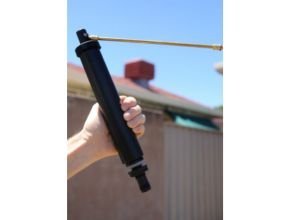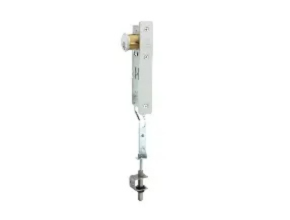Description of Philmac Cistern Valve
Philmac’s plastic cistern valve is a compact unit offering easy installation and operation guaranteeing constant water level is maintained. The simple design and features of the cistern valve ensure the filling of the tank is slow and controlled avoiding water hammer.

The valve also includes a built-in reservoir tube (baffle) ensuring a silent operation. Philmac’s robust cistern valves are manufactured from high-grade quality materials providing corrosion and impact resistance.
Application of Philmac Cistern Valve
- Industrial: Commercial airconditioning units and toilet cisterns.
- Water Storage Tanks – Regulates water flow in household, industrial, or agricultural water tanks.
- Irrigation Systems – Used in water storage containers for agriculture and livestock.
- Toilets & WC Cisterns – Controls the filling of water in toilet flush systems and bathroom cisterns.
- Industrial & Commercial – Used in water treatment systems and other liquid storage.
Benefits of Philmac Cistern Valve
Fast and Easy Installation
- Easy Disassembly: The valve has been designed for easy replacement of the rubber seal without having to uninstall the valve. Simply remove the pivot pin and the lever assembly then unscrew the pillar cap and remove the plunger/seal.
- Minimum Space Required for Installation: Based on a compact body design the valve is perfect for tight applications such as a small cistern.
- BSP Inlet Threads: The Plumbing and Irrigation sectors use British Standard Pipe (BSP) threads as a standard. Philmac also uses these thread types across the valve range to ensure compatibility with other threaded fittings and make installation easy.
High Performance
- Manufactured from advanced thermoplastic materials: Philmac’s cistern valve bodies are manufactured from lightweight high performance thermoplastic material that has excellent impact, UV, and corrosion resistance. The material is non-toxic and taint-free.
- Manufactured from DZR brass: Philmac cistern valves also utilize a brass lever assembly. These are manufactured from dezincification-resistant (DZR) brass which means the brass is resistant in soil and water environments to corrosion involving the loss of zinc leaving a residue of spongy or porous copper.
- High-pressure shutoff: Cistern valves are rated to a pressure of 1400 kPa (200 psi) or 14 bar (static shutoff). This is based on using a 100mm (4”) float (ball).
- Quiet operation: A built-in reservoir tube (noise baffle) minimizes noise for a quiet operation.
Complete Security
- Reliable Operation: Consistent high-quality injection molded plastic bodies plus plastic and brass engineered components means years of reliable operation.
- Corrosion Resistant: The body, cap, and piston are manufactured from plastic. The seal and O-ring are manufactured from Nitrile rubber. The lever assemblies and pivot pins are manufactured from DZR brass ensuring all components used have a high degree of corrosion resistance.
- Approvals: All valves comply with Australian Standard AS 1172.2 which means that the valves meet performance requirements for backflow prevention, back siphonage and endurance testing, as well as material construction requirements.
- Positive Shut-Off: The action between the lever assembly and piston ensures the piston provides a complete seal against the water inlet and prevents unwanted loss of water.
Standards and Tests of Philmac Cistern Valve
Philmac’s range of sleeve valves are designed to comply with the following standards and Philmac undertakes a range of tests to ensure they comply with these standards.
Standards
- ISO 228.1: Pipe threads where pressure-tight joints are made on the threads.
- AS1722.1: Pipe threads of Whitworth form part 1: sealing pipe threads.
- AS 1172.2: Technical specifications for plumbing and drainage products – cistern inlet valves.
Test
- Shutoff Test: Valves are tested for shut-off against a hydrostatic water pressure of 2000 kPa (290 psi) or 20 bar.
- Endurance Test: Operating mechanisms are subjected to 50,000 cycles. This simulates opening and closing operations during the design service life of the valve.
- Backflow Prevention / Back Siphonage: The valve is tested to show that no cistern water can return to the main supply when set up to the requirements of AS/NZS 3500.1.
Operation & Installation Instructions of Philmac Cistern Valve
The Philmac cistern valves operate by opening and closing a plunger against a seat through the action of a lever arm attached to a float. The lever arm is interconnected to the plunger via a cam. As the water level drops, the float and lever arm move in a downward direction allowing the plunger to move away from the seat, which opens the valve. When the water level rises, the float and lever arm move in an upward direction and the plunger moves towards the seat until it sits firmly against the seat and shuts the valve off.
- Insert the cam end of the lever assembly into the valve plunger recess. This may require rotation of the plunger to align it to the correct position. Align the cam hole with the valve housing and insert the pivot pin then flare the ends to secure.
- Remove the back nut from the bottom of the valve and insert the threaded section of the valve into the base of the cistern or small tank. Ensure the stem sleeve is in direct contact with the base of the tank so that it seals and prevents water from leaking.
- Screw the back nut onto the thread and tighten.
- Where necessary bend the lever arm to adjust the water level. This can be done by removing the lever arm assembly by first straightening the tabs on the end of the pivot pin with a pair of pliers and then sliding it out. By using a pair of multi-grips or equivalent the lever can then be bent to the necessary angle. Adjust the lever arm and then refit. Once the correct lever arm angle is achieved ensure the pivot pin tabs are flared outward by using a small screwdriver.
Souce: philmac.com.au
Read More Articles:
- Alicat PS–Series Anti-Corrosive Absolute and Gauge Pressure Transducers
- Alicat P-Series Absolute and Gauge Pressure Transducers
- Oil Skimmers Extended Reach Oil Skimming Systems
- Oil Skimmers Frame Mounted Oil Skimming Systems
- Oil Skimmers ESS Enclosed Skimming System




